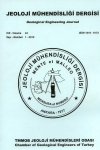
ABSTRACT: Çanakkale Altınoluk (Papazlık) Pb-Zn mineralization is observed in amphibole-gneiss andmarbles of Fındıklı Formation, generally concordant with the host rocks and in fault zones whichintersect the host rocks.Ore minerals composed of galena, pyrite, chalcopyrite, sphalerite, phyrrothite, gold, hematite,rutil, ilmenite and other ores of replacement products.Ore samples include; 89 - >10000 ppm Pb, 129 - >10000 ppm Zn, 24 4136 ppm Cu, 0.31 6.79 % Fe, 71 2479 ppm Mn, 189 514.30 ppb Ag and 0.6 76513 ppb Au.From the geostatistical studies performed on ore and host rock samples; element assemblagesof Ti, Cr, Mg, Ca, Sr, Al represent the basic rocks and carbonates, Na, K, Rb, Ba representthe possible late hydrothermal stage, and Pb, Cu, Ag, Fe, ±Mn, ±Ni, ±Zn, ±Au represent themineralization.High ratio of Cr, Ti, Ni and Co element contents which are determined in the ore and hostrocksindicate the probable volcano-sedimentary characteristic of pre-metamorphism succession.In this study, the obtained data point out the primary source of the mineralization can besupposed to SEDEX type (Exhalative Sedimentary Type) enrichments. Further metamorphismand deformations may lead to the present position of mineralizations. In addition, the effects oflate hyrothermal stage elements derived from granitic rocks exposed around the region, can carrytraces though in limited ratios on mineralizations.
ABSTRACT: İn the northern parts of Otlukbeli thevolcaniclastic rocks which belong to Liassicaged Kelkit Formation, are found on thebottom. These rocks are overline by theHozbirik Yayla limenstones which are formedby micritic limenstones of Malm-LowerCretoceaus. The Otlukbeli Melange has beentrusted on these limenstones and was formedand located in the Aptian and Albian. All o theseunits are cross cut by the Sarıhan granitoid ofCampanian age. Youngest unit of the area isthe Sarıtaşlar Formation, which composed ofconglomerate,sansstone and shale alternation.The Mn mineralizationsin the area are found inthe radiolarites within the Otlukbeli Melange.The most important of these mineralizationsisthe Kuşkayası ore deposit. The vein shapeddeposit is 180 m. İn length, 2 m. İn averagethickness and has a width more than 40 m.in dip direction. The major ore minerals arebraunite, pyrolusite, psilomelane, bixibite andmanganite. The interpretation of geochemicaldiagrams prepared for major and traceelements contens revealed that the ore depositswas hydrothermal in origin. At present he oredeposits contains commercially more than12.000 tons of Mn.
ABSTRACT: The method of biogeochemical prospection, with aim of exploring unknown mine ores, baseson the principle of chemical analysis of plant samples, for the purpose that are called indicator,accumulator and hyperaccumulator. Accumulator plants have the ability to take up large amountsof metals from soils. Because of this , three species ( Alyssum murale Waldst & Kit, Alyssumfloribundum Boiss & Ball, Alyssum peltarioides, Boiss, subsp, virgatifarme (Ngar)) of Alyssum(in leaves ,twigs and flowers) and soil samples were collected from 42 sites in the FındıkpınarıErdemli/Mersin) area, were chemical analysed for their Ni, Co, Fe, Cu, Mn ve Zn contents .Theseelements of samples were determined by flame atomic absorpsiyon spectrofotometer. Data for thestatistical significance of plant/soil relationship for Ni are summarised. The A. murale (n: 20,r: 0.8879 and for extreme Ni , n: 4, r: 0.9873, P<0.05, %95 , in flowers) species for Ni showedhighly significant, (P<0.01, %99 with reliability.) relationships. This plant species is apparentlygood accumulator for Ni element and could be succesfully used for the further biogeochemicalprospecting and environmental monitoring.

 TMMOB
TMMOB